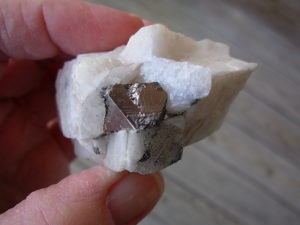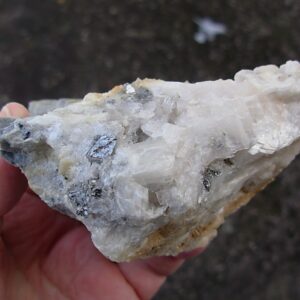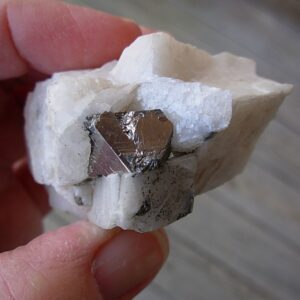Carrollite

Carrollite 002
Carrollite was named after its occurrence in Carroll Co. Maryland, US, at the Patapsco mine, Sykesville. Carrollite is a sulfide of copper and cobalt, sometimes with substitution of nickel for the metal ions. It belongs to the Linnaeite group. Carrollite occurs in hydrothermal vein deposits and can be identified in the field by its color variations, such as gray, copper red, light gray, and steel. Its opaque form has indistinct cleavage and a metallic luster. It is often associated with minerals such as Tetrahedrite, Linnaeite, Siegenite, Polydymite, Digenite, Pyrite, Chalcopyrite, Bornite, Chacocite, Pyrrhotite, Sphalerite, Millerite, Gersdorffite, Ullmannite, Cobaltoan Calcite, and Djurleite.
Carrollite has been found and mined in the following places:
USA in Carroll Co. Maryland, Patapsco mine, Finksburg and the Mineral Hill mine, Sykesville
Mexico at Boleo, Baja California
Bulgaria near Chernomorets, Burgas
Chile in the Carrizal Alto copper district, Atacama
Slovakia at Vysna Boca, Nizke Tatry Mountains
Germany in the Kohlenbach mine, near Eiserfeld, and the Siegerland district, North Rhine-Westphalia
Sweden in Gladhammar, Kalmar
Japan in the Sazare mine, Ehime Prefecture, and the Shirataki mine, Kochi Prefecture
North Korea at the Hol Kol Au–Cu mine, about 75km southeast of Pyongyang, Suan Co.
Namibia at Tsumeb
Zimbabwe at the Madziwa (Dry Nickel) mine, Bindura, and Shamva
Congo from Kambove, and in the Kamoto and Musonoi mines, near Kolwezi, Katanga Province
Zambia from the Rokana mine, Kitwe
Australia from Kambalda, 56km south of Kalgoorlie, Western Australia
References
https://www.azomining.com/Article.aspx?ArticleID=1013; Carrollite - RruffProject Website-University of Arizona; Carrollite – Webmineral;
Carrollite – Mindat; https://en.wikipedia.org/wiki/Carrollite


